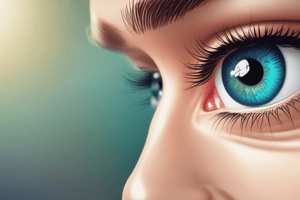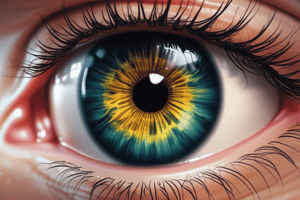Podcast
Questions and Answers
What is the average blink rate in a healthy individual?
What is the average blink rate in a healthy individual?
- 24 blinks per minute (correct)
- 34 blinks per minute
- 20 blinks per minute
- 10 blinks per minute
Which of the following is a non-invasive technique for assessing the tear layer?
Which of the following is a non-invasive technique for assessing the tear layer?
- Break-Up-Time (BUT)
- Schirmer test
- Lissamine Green staining
- Tear prism height (correct)
Which condition is NOT considered when assessing general health in relation to refraction?
Which condition is NOT considered when assessing general health in relation to refraction?
- Pregnancy
- Hobbies (correct)
- Systemic medications
- Ocular conditions
Which invasive assessment technique is specifically used to evaluate tear break-up time?
Which invasive assessment technique is specifically used to evaluate tear break-up time?
What should be considered as part of the final evaluation for trial fitting of contact lenses?
What should be considered as part of the final evaluation for trial fitting of contact lenses?
What is a primary feature of silicone acrylate materials used in lenses?
What is a primary feature of silicone acrylate materials used in lenses?
Which property of Fluoro-Siloxane Acrylates improves their performance over regular silicone acrylate?
Which property of Fluoro-Siloxane Acrylates improves their performance over regular silicone acrylate?
What characteristic do soft contact lens materials primarily share?
What characteristic do soft contact lens materials primarily share?
How are synthetic elastomers distinct from other contact lens materials?
How are synthetic elastomers distinct from other contact lens materials?
What is the significance of having a high Dk value in contact lens materials?
What is the significance of having a high Dk value in contact lens materials?
Which of the following materials does NOT belong to the soft contact lens materials category?
Which of the following materials does NOT belong to the soft contact lens materials category?
What type of polymer base is used for thermoplastics in contact lens material?
What type of polymer base is used for thermoplastics in contact lens material?
What is a notable benefit of high water content lenses?
What is a notable benefit of high water content lenses?
What characterizes mid water contact lenses?
What characterizes mid water contact lenses?
Which manufacturing process uses liquid polymer injected into a spinning mold?
Which manufacturing process uses liquid polymer injected into a spinning mold?
What is the average corneal thickness as noted in clinical studies?
What is the average corneal thickness as noted in clinical studies?
What does the refractive index calibration for the cornea typically use?
What does the refractive index calibration for the cornea typically use?
What is a primary disadvantage of using photokeratoscopes?
What is a primary disadvantage of using photokeratoscopes?
What is the formula to compute the power of the cornea based on the radius?
What is the formula to compute the power of the cornea based on the radius?
Which method is used to assess the peripheral curvature deviation in corneal asphericity?
Which method is used to assess the peripheral curvature deviation in corneal asphericity?
What is a characteristic of the cornea's apical area?
What is a characteristic of the cornea's apical area?
What is the purpose of the slit-lamp examination during the preliminary examination?
What is the purpose of the slit-lamp examination during the preliminary examination?
Which of the following is NOT part of the ocular dimensions measurement?
Which of the following is NOT part of the ocular dimensions measurement?
How is lid tension graded according to Swarbrick & Holden?
How is lid tension graded according to Swarbrick & Holden?
What does HVID and VVID measure in ocular dimensions?
What does HVID and VVID measure in ocular dimensions?
Which grading system is NOT mentioned for ocular health assessment?
Which grading system is NOT mentioned for ocular health assessment?
Which measurement is important for evaluating corneal curvature?
Which measurement is important for evaluating corneal curvature?
What is typically assessed during biomicroscopy in contact lens fitting?
What is typically assessed during biomicroscopy in contact lens fitting?
Which structure is NOT included in the preliminary examination of the anterior segment?
Which structure is NOT included in the preliminary examination of the anterior segment?
Why is basal measurement important before contact lens fitting?
Why is basal measurement important before contact lens fitting?
In terms of lid positions and shape, how do the measurements differ for Asians?
In terms of lid positions and shape, how do the measurements differ for Asians?
What is the primary characteristic of aphakia?
What is the primary characteristic of aphakia?
What does the term 'CLM' represent in relation to retinal image sizes?
What does the term 'CLM' represent in relation to retinal image sizes?
Which statement is true regarding the impact of switching from spectacles to contact lenses for myopes?
Which statement is true regarding the impact of switching from spectacles to contact lenses for myopes?
What is a significant optical advantage of contact lenses compared to spectacles?
What is a significant optical advantage of contact lenses compared to spectacles?
What defines the concept of convergence in relation to hyperopia?
What defines the concept of convergence in relation to hyperopia?
What is a common disadvantage of using contact lenses?
What is a common disadvantage of using contact lenses?
Which condition would cause meridional aniseikonia when using spectacle lenses?
Which condition would cause meridional aniseikonia when using spectacle lenses?
What consequence does the prismatic effect have when the line of sight does not align with the optical center of a lens?
What consequence does the prismatic effect have when the line of sight does not align with the optical center of a lens?
What is the result of lens decentration in contact lenses?
What is the result of lens decentration in contact lenses?
What does Prentice's Rule help to calculate?
What does Prentice's Rule help to calculate?
Flashcards
Break-Up-Time (BUT)
Break-Up-Time (BUT)
A test that measures the time it takes for the tear film to break up after a blink.
Tear prism height
Tear prism height
The measurement of the tear film's thickness at the edge of the eyelid.
Spectacle Plane Refraction
Spectacle Plane Refraction
A procedure to determine the patient's refractive error using the spectacle plane.
General Health Factors
General Health Factors
Signup and view all the flashcards
Occupational, Recreational, and Environmental Factors
Occupational, Recreational, and Environmental Factors
Signup and view all the flashcards
High Water Content Lenses
High Water Content Lenses
Signup and view all the flashcards
Mid Water Contact Lenses
Mid Water Contact Lenses
Signup and view all the flashcards
Spincasting (Lens Manufacturing)
Spincasting (Lens Manufacturing)
Signup and view all the flashcards
Lathe Cutting (Lens Manufacturing)
Lathe Cutting (Lens Manufacturing)
Signup and view all the flashcards
Cast Molding (Lens Manufacturing)
Cast Molding (Lens Manufacturing)
Signup and view all the flashcards
Horizontal Corneal Diameter (HVID)
Horizontal Corneal Diameter (HVID)
Signup and view all the flashcards
Vertical Corneal Diameter (VVID)
Vertical Corneal Diameter (VVID)
Signup and view all the flashcards
Corneal Thickness
Corneal Thickness
Signup and view all the flashcards
Pachymeter
Pachymeter
Signup and view all the flashcards
Silicone acrylate
Silicone acrylate
Signup and view all the flashcards
Fluoro-Siloxane Acrylates (FSAs)
Fluoro-Siloxane Acrylates (FSAs)
Signup and view all the flashcards
Perfluoroethers
Perfluoroethers
Signup and view all the flashcards
PHEMA
PHEMA
Signup and view all the flashcards
Thermoplastics
Thermoplastics
Signup and view all the flashcards
Synthetic Elastomers
Synthetic Elastomers
Signup and view all the flashcards
Hydrophilic Contact Lens Materials
Hydrophilic Contact Lens Materials
Signup and view all the flashcards
SM (Spherical Modulation)
SM (Spherical Modulation)
Signup and view all the flashcards
CLM (Contact Lens Modulation)
CLM (Contact Lens Modulation)
Signup and view all the flashcards
RSM (Relative Size Modulation)
RSM (Relative Size Modulation)
Signup and view all the flashcards
Aphakia
Aphakia
Signup and view all the flashcards
High Corneal Astigmatism
High Corneal Astigmatism
Signup and view all the flashcards
Meridional Anisikonia
Meridional Anisikonia
Signup and view all the flashcards
Incipient Presbyopia
Incipient Presbyopia
Signup and view all the flashcards
Prismatic Effect
Prismatic Effect
Signup and view all the flashcards
Prentice's Rule
Prentice's Rule
Signup and view all the flashcards
Convergence
Convergence
Signup and view all the flashcards
Preliminary Examination of the Anterior Segment
Preliminary Examination of the Anterior Segment
Signup and view all the flashcards
Pupil Response to Light
Pupil Response to Light
Signup and view all the flashcards
Keratometry
Keratometry
Signup and view all the flashcards
Corneal Topography
Corneal Topography
Signup and view all the flashcards
Horizontal Visible Iris Diameter (HVID)
Horizontal Visible Iris Diameter (HVID)
Signup and view all the flashcards
Vertical Visible Iris Diameter (VVID)
Vertical Visible Iris Diameter (VVID)
Signup and view all the flashcards
Lid Tension
Lid Tension
Signup and view all the flashcards
Slit-Lamp Biomicroscopy During Contact Lens Fittings
Slit-Lamp Biomicroscopy During Contact Lens Fittings
Signup and view all the flashcards
Spectacle Refraction
Spectacle Refraction
Signup and view all the flashcards
Pre-Contact Lens Biomicroscopy
Pre-Contact Lens Biomicroscopy
Signup and view all the flashcards
Study Notes
Contact Lenses
- Defined as a thin medical device placed directly on the eye's surface, used to correct vision.
History of Contact Lenses
- Leonardo da Vinci (1508): First concept of a lens in contact with the eye.
- John Herschel (1827): Described a glass contact lens shaped to match the eye.
- F.E. Muller (1887): Fitted a blown glass lens to an eye removed surgically.
- A.E. Fick (1888): Described the first contact lens intended for vision correction.
- Muller and Obrig (1938): Created the first plastic scleral contact lens.
- E. Kalt (1940s): Designed and fitted glass corneal contact lenses. All available contact lenses at that time were scleral-type.
- Kevin Touhy (1947): Created the first plastic corneal lens from PMMA.
- Otto Wichterle: Developed HEMA.
Classification of Contact Lenses
By Material
- Hard: Non-gas permeable, Gas permeable
- Soft:
- Conventional
- Disposable
By Design
- Monocurve
- Bicurve
- Tricurve
- Aspheric
By Size
- Corneal
- Semi-corneal
- Scleral
By Mode of Use
- Daily Wear:
- Disposable
- Planned replacement
- Extended:
- Continuous wear
- Flexible wear
By Purpose or Use
- Optical:
- Spherical
- Toric
- Presbyopic
- Therapeutic
- Cosmetic
Spherical Contact Lens
- Used to correct hyperopia, myopia, aphakia, and a small amount of astigmatism.
- Available in a wide range of corrections (-20.00D to +20.00D).
Toric Contact Lens
- Used to correct significant astigmatism.
Presbyopic Correction
- Monovision/Monofit: One eye fitted for distance, the other for near vision.
- Bifocal soft contact lens: Alternating vision for distance and near through different portions of the lens.
- Multifocal: Patient views through both distance and near portions simultaneously.
Tinted Contact Lenses
- Visibility tints (effective on lighter colored eyes).
- Makes handling easier.
- Opaque colored lenses: Change the apparent color of the eye.
Therapeutic (Bandage) Lenses
- Used to promote healing of different corneal disease conditions.
Modern Contact Lenses
- Ortho-K contact lenses: Gas-permeable lenses that temporarily reshape the cornea to correct refractive errors (myopia, hyperopia, astigmatism).
- Hybrid contact lenses: Large-diameter lenses with a rigid gas-permeable central zone, surrounded by a peripheral zone made of soft or silicone hydrogel material.
- Wink-activated telescope contact lens: 1.55mm thick, extremely thin reflective telescope, activated by eye blinks (magnifies 2.8x).
- Google contact lens (prototype): Monitors glucose levels in tears.
- Triggerfish contact lens (SENSIMED): Embeds a micro-sensor that measures intraocular pressure.
- iOptik contact lens: Enhances vision by allowing light from the display to pass through the center of the pupil, while light from the surrounding environment passes through the outer portion of the pupil.
- Terminator Eyes contact lens: Shows images like road directions and text messages from smartphones.
Contact Lens Parameters
Base Curve (BC)
- Radius of curvature of the posterior zone.
Optic Zone (OZ)
- Posterior central optic portion of the lens, indicating the usable portion.
- SCL: 7-12 mm
- RGP: 7-9 mm
Lens Diameter (LD)
- Maximum external dimension of the lens.
- SCL: 13-16 mm
- RGP: 8-20 mm
Posterior Peripheral Curve Radius (PPCR)
- Radius of the peripheral curve.
Peripheral Curve Width (PCW)
- Width of the posterior peripheral curve portion of the lens.
Sagittal Value (Sag)
- Distance from the line between the outer edges of the lens to the center of the back surface.
Optic Cap (OC)
- Central anterior optic portion of a lens.
Optic Cap Radius (OCR)
- Radius of the central anterior optic portion of a lens.
Anterior Peripheral Curve Zone (APCZ)
- Anterior peripheral or lenticular portion of the lens.
Lens Thickness (CT)
- Central Thickness (CT)
- SCL: 0.035-0.2 mm
- RGP: 0.1–0.2 mm
- Edge Thickness (ET)
- SCL: 0.01-0.05 mm
- RGP: 0.08 -0.12 mm
Properties of Contact Lens Materials
Oxygen Performance
- Lens acts as a barrier to atmospheric oxygen.
- Corneal physiological processes compromised without enough oxygen.
- Short-term problems: Central Corneal Clouding, Vertical striae, Microcysts, Epithelial and stomal thinning.
- Long-term problems: Corneal distortion, Disruption of endothelium, Changes in refractive status of the eye.
Dk (Oxygen Permeability)
- Quality of material allowing oxygen to travel through it.
- D = diffusion coefficient, k = solubility coefficient
- Higher water content = higher the Dk
- Low Dk = less than 30
- Medium Dk = 30-60
- High Dk = higher than 60
Dk/t (Oxygen Transmissibility)
- States how much oxygen passes through the lens.
- Thinner lens = more oxygen passing through.
- 25 for daily wear, 87 and above for overnight wear
EOP (Equivalent Oxygen Permeability)
- Describes oxygen flux through contact lens like corneal response.
- Measurement of the cornea's oxygen thirst following lens wear.
- Assesses various lens thicknesses to compare performances.
Corneal Swelling
- Most valid indicator of real-life clinical performance. Measures the percent increase in corneal thickness.
Tensile Properties
- Measures the physical tensile properties of a material.
- Tensile strength: Force applied before breakage.
- Modulus of elasticity: Flexibility/stretchability.
- Coefficient of elongation: Stretching percentage before breakage.
- Tear strength: Force causing a tear in material.
Water Content
- Higher water content lenses provide more oxygen to the cornea.
- High-water-content materials lose more water.
Refractive Index
- Defines how light rays are affected passing through a material.
- Important for achieving the proper optical effect on the eye.
- Higher water content = lower refractive index.
- Requires thicker lens design for lower refractive indices.
Biocompatibility
- Contact lenses interact with corneal tissue.
- Importance of assessing physiological balance.
- Several different tests are used for evaluation:
- 21-Day Rabbit Test
- Resistance to microbial growth
- Compatibility of the lens material with care systems
Protein Deposits
- During development, lens materials are evaluated for protein uptake.
- High water content lenses absorb more protein.
Dimensional Stability
- Assessed by measuring water content, sagittal value, power, thickness, and base curve.
- Ensures consistent lens performance.
Hydrolytic Stability
- Since contact lenses are placed in the tear film (primarily water), the hydrolytic stability of the material is assessed.
- Only materials stable in water are suitable for contact lenses.
Lens Handling
- Handling eases with more rigid lens materials.
Wettability
- Characteristic of lens performance important to RGP materials.
- Soft materials are inherently hydrophilic.
- RGP materials (silicone) can act as water repellents.
- Wettability is tested by measuring the wetting angle.
- Lower wetting angle (closer to 0) indicates higher wettability, while higher wetting angles indicate lower wettability.
Rigid Contact Lens Materials
- Material primarily used for rigid lenses: PMMA.
- Stable
- Resistant to warpage; wets well and clean easily.
- Lack of permeability to oxygen and tear exchange phenomena.
Gas Permeable Lens Materials
- Cellulose acetate butyrate (CAB): Low oxygen permeability.
- Silicone acrylate: Combined with PMMA; high Dk values; Introduced in 1970.
- Fluor-siloxane acrylates (FSAs): Higher Dk values with enhanced wettability, but risk of scratching.
- Perfluoroethers: High Dk.
Soft Contact Lens Materials
- PHEMA is similar to PMMA with added hydroxyl groups, making it hydrophilic.
- Water content is ~38%
- Other variants exist to further improve PHEMA.
Ideal Contact Lens Material Properties
- Needs to meet corneal oxygen requirements.
- Needs to be physiologically inert.
- Needs optimal in vivo wetting properties.
- Needs to be dimensionally stable.
- Needs to be durable, optically transparent, and require minimal patient care; Needs to be easily machineable.
Important Material Properties
- Oxygen permeability
- Wettability
- Scratch resistance
- Rigidity (for rigid gas-permeable lenses)
- Flexibility (for soft contact lenses)
- Durability
- Deposit resistance
Optical Properties
- Refractive index
- Spectral transmission
- Dispersion
Corneal Topography: Measurement and Significance
-
Normal Corneal Dimensions and Topography:
- HVID (horizontal visual diameter): 10-14 mm, average 11.7 mm
- VVID (vertical visual diameter): 10.6 mm, smaller than HVID (0.5-1.0 mm)
-
Corneal Thickness:
- Clinical studies: 0.50-0.65 mm
- Gullstrand's Eye No. 1: 0.50 mm
-
Variations in Central & Peripheral Thickness
-
Corneal Measurement: Pachometers (ultrasonic, beam-splitting device on slit-lamp)
-
Corneal Curvature: Characteristics of the central corneal region, Peripheral portion (limbus) and Limbal topography influencing SCL fitting.
-
Corneal Topography Asphericity: Cornea is aspheric, apex area has shortest radius, Deviation of peripheral curvature from apical curvature called asphericity, Prolate (normal), Oblate (laser surgery or ortho-k)
-
Uses: Estimation of refractive errors, Assessment of pathology, Contact lens fitting, effects of contact lenses and refractive surgery.
-
Instrumentation: Optical (photokeratoscope, placido disc, keratometer), Computer assisted tomography, Contact methods (casting and molding, ultrasound, trial contact lenses)
-
Photokeratoscope Images:
- Patterns depicting astigmatism, scars, irregularities, and keratoconus.
Disadvantages of Photokeratoscopy
- Corneal astigmatism is not quantified.
- Absence of central-mire reflection may limit field size.
Keratometers
- Measure the radius of curvature of the optic cap (3-4 mm).
- Measures the total power of the cornea.
- Types: 2-position, 1-position.
Contact Lens Nomenclature
- Contact lens materials are broadly classified as hydrophilic and hydrophobic.
- Materials with high water percentage are categorized with "-filcon" name.
Contact Lens Material Categorization
- Based on ionic or non-ionic nature, as well as water content: Materials with high water percentage are "-filcon" materials, while "-focon" are those with low-wat content.
Ionic vs Non-Ionic Contact Lens
Ionic:
- interact with polar molecules (water)
- increase lens hydration
- more sensitive to changes in PH and osmolality
- Greater interaction with ocular environment and increase in protein uptake. Non-ionic:
- interact with water without a formal charge
- do not greatly influence lens hydration
Low Water Content Lenses
- Provide excellent physiological response for patients with refractive errors.
- Compatible with most lens care systems.
- Lower protein uptake tendencies which leads to longer lens life. Higher tensile strength.
- Exhibit good material stability.
- Don't absorb preservatives (no discoloration).
High Water Content Lenses
- High oxygen permeability; excellent for thicker high plus/minus lenses.
- Lower tensile strength.
- Not compatible with all lens care systems.
- Higher incidence of acute red eye and lens discoloration. Usually produced by lathe cut or cast molding process.
Mid Water Content Lenses
- Typically ionic or non-ionic materials.
- Attempt to combine best qualities of high & low water materials.
- Good physiology; thin, comfortable designs.
- Increased protein uptake is a characteristic.
- Usually not compatible with thermal disinfection techniques.
Manufacturing Process
- Spincasting
- Lathe Cutting
- Cast Molding
Optics of Contact Lenses (Correction for Ametropia)
- Establishing the appropriate power of contact lens based on manifest refraction result, sphere amount, cylinder amount, sphere-cylinder ratio and vertex distance of refraction.
- Spherical equivalent of the contact lens prescription.
- Correcting for vertex distance: Formula for contact lens prescription power (DCL) adjusted for vertex distance.
Contact Lens Magnification
- Relative size of image seen through contact lenses in comparison to spectacles.
- Hyperopes tend to experience a smaller image size in contact lenses than with spectacles. Myopes experience the opposite; a larger image in contact lenses versus spectacles.
Relative Magnification
- Helpful specifically for anisometropia.
- Aetiology of the ametropia may be unknown in some cases.
- K readings may mirror ametropia, suggesting potential refractive issue.
Specialized Considerations
-
Axial ametropia, refractive ametropia
-
Aphakia (where IOLs are not implanted- contact lenses are preferred).
-
High corneal astigmatism (considered refractive ametropia). Spectacle lenses can cause significant meridional aniseikonia.
-
Incipient Presbyopia: How contact lens use can affect near vision capabilities.
-
Prismatic effect: Induced if line of sight does not pass through the optical center of the lens.
Convergence in Hyperopia and Myopia
- Contact lenses increase convergence difficulty for hyperopes and decrease for myopes.
Optical Advantages of Contact Lenses
- Eliminates astigmatism in oblique pencils.
- No image distortion.
- No chromatic aberration.
- No limitations on the field of view.
- No spectacle frame diplopia.
Optical Disadvantages of Contact Lenses
- Lens decentration can produce "ghosting."
- Toric lenses rotating may result in refraction and decreased vision.
- Moving lenses can cause vision disturbances.
Routine Preliminary Examination for Contact Lenses
- Slit-lamp examination of anterior segment.
- Measurement of ocular dimensions.
- Assessment of tears (tear flow, volume, break-up time, osmolality, pH).
- Spectacle refraction.
- Preliminary examination of anterior structures: Eyelids, Conjunctiva, Tears, Cornea, Anterior Chamber, Iris, and Lens, using Ocular Health Grading System.
- Biomicroscopy before fitting, during, and after fitting to assess lens fit and identify anterior eye changes.
- Other considerations:
- Corneal curvature (central and peripheral keratometry, shape regularity, corneal vs internal astigmatism).
- Corneal measurements (HVID and VVID).
- Palpebral aperture (lids' size and shape).
- Lid tension.
- Blink rate.
Studying That Suits You
Use AI to generate personalized quizzes and flashcards to suit your learning preferences.
Related Documents
Description
Test your knowledge on contact lenses with this quiz focusing on materials and evaluation methods. Explore the average blink rate, non-invasive assessment techniques, and the distinctions among various contact lens materials. Perfect for students and professionals in optometry or ophthalmology fields.




